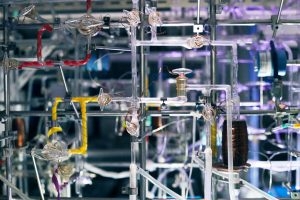Hopes have been rising for hydrogen as a future energy source because, unlike fossil fuels, it does not emit CO2 when burned, only water. The problem is hydrogen is currently produced industrially, primarily by consuming fossil fuels and emitting CO2. So, for hydrogen to be considered a clean energy source, it needs to be produced from water using solar power or other renewable energy sources. It is possible, for example, to produce hydrogen using solar power generation and water electrolysis, but this method has not proved to be practical. The Tokyo University of Science, on the other hand, is researching photocatalysts as a way to obtain hydrogen from water without electrolysis. This is a revolutionary method that generates hydrogen simply by placing a substance such as a metal oxide that serves as a photocatalyst in water and exposing it to light. A tremendous amount of hydrogen will be needed to run a hydrogen-based society. Professor Kudo explains the situation. “Green hydrogen is the name for hydrogen produced from water using a renewable energy without emitting CO2. But unless we have stable systems to supply green hydrogen inexpensively, we won’t fundamentally solve our resource, environmental, and energy problems.”

Materials R&D is the key to producing green hydrogen by means of photocatalysts. To be more specific, researchers are searching for photocatalytic materials that can generate hydrogen more efficiently. Professor Kudo describes the core problem. “We have been researching photocatalysts for many years and we have made significant strides in improving their efficiency. But whether we will reach the social implementation stage in the future rests on whether we can develop a breakthrough material.” Strontium titanate is a common water-decomposing photocatalyst, but it reacts only to ultraviolet light, so it is not efficient at generating hydrogen. The research into increasing photocatalyst efficiencies is focused on developing substances that react to all light wavelengths in a solar spectrum and can be converted into a convenient powdered form. Professor Kudo explains, “Our mission is to develop the underlying technology for a hydrogen production plant. Such a plant will be covered with glass panels that have photocatalytic powder coatings. The panels will be filled with water and exposed to sunlight to extract hydrogen.” “We are taking a new perspective on developing photocatalytic materials by measuring the electrical properties of the photocatalysts developed by Dr. Kudo’s group and applying additional electrochemical processing,” said Associate Professor Tanaka. The two teams are working on the research together, hoping to benefit from synergistic effects by linking each team’s elemental technologies.

Hydrogen is a vital material for the chemical industry. Professor Kudo describes its importance. “Chemical producers are able to manufacture many kinds of chemical products by reacting different substances with hydrogen. One of the most important of these products is ammonia. Ammonia is an essential ingredient in nitrogen fertilizer, which is indispensable for growing crops.” In addition, methane, the key component of city gas, is produced by reacting hydrogen and CO2. Research is proceeding at the Tokyo University of Science into generating methane by placing a photocatalyst in water and then adding CO2. If fossil fuels are depleted or global warming intensifies in the coming years, it is very likely that producing hydrogen as we have, which involves emitting CO2, will become unviable. This further heightens the urgency to develop technologies to produce green hydrogen.
■ Main research themes
■ Main research themes